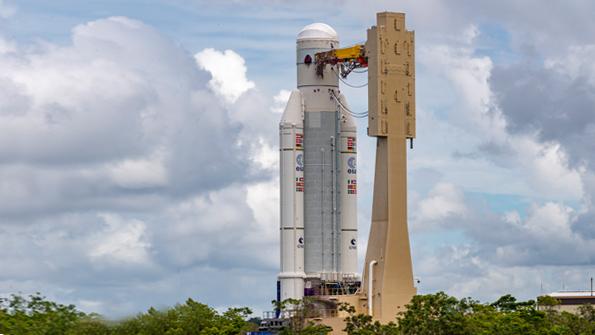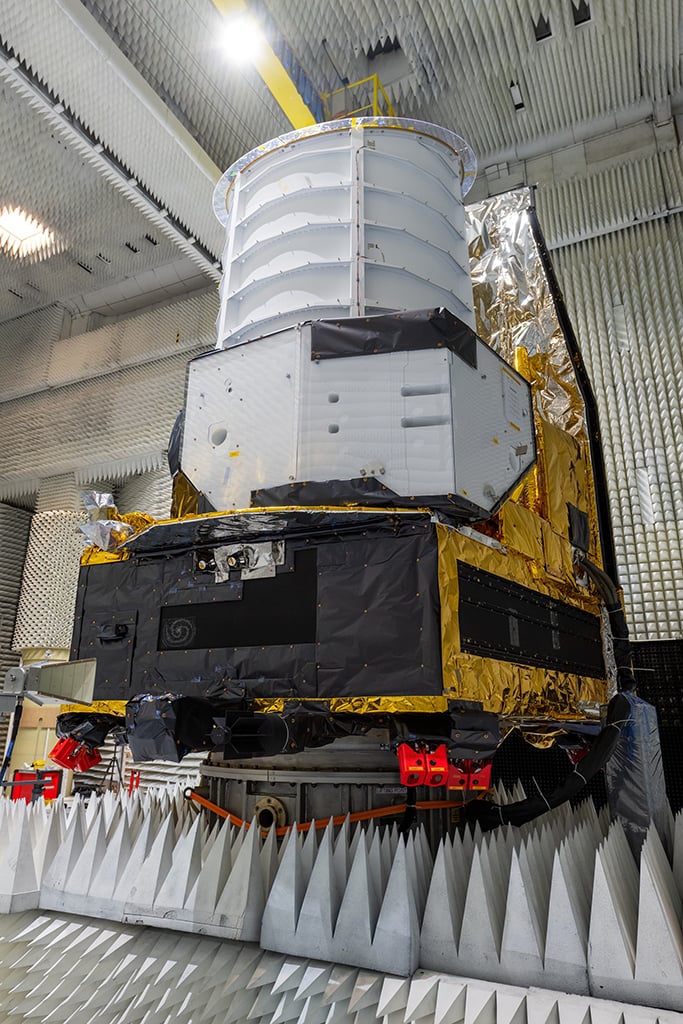
Arianespace’s 117th and last Ariane 5 rocket headed to the final assembly building at the European Space Agency’s Kourou, French Guiana, launch site on May 31. Liftoff was targeted for June 16.
More than 45 years ago, France and other partners in the European Space Agency largely ignored U.S. insistence that its space shuttles were going to make expendable launch vehicles obsolete.
That foresight set the stage for the creation of Arianespace, the world’s first commercial space launch company. With backing from the European Space Agency (ESA), which eyed an indigenous launch capability to bolster its science programs and industries, Arianespace quickly rose to dominance. By 1984, half of the world market for satellite launches were booked on Arianespace Ariane rockets.
- Ariane 6 debut no earlier than late 2023
- European fleet down to two Vega rockets
- U.S. launch companies in transition
By 2001, Arianespace began to face competition from U.S., Russian and Chinese launch providers, which it addressed with price cuts and the upgraded Ariane 5. But that was just a harbinger of industry disruption ahead.
With its novel technology and discount fees, the U.S. company SpaceX overtook Arianespace as the world’s commercial launch leader in 2017. Last year, SpaceX launched Falcon rockets 61 times, compared to six missions for Arianespace, including one onboard a Russian Soyuz rocket flying from the ESA-owned spaceport in French Guiana.
The European-Russian launch partnership ended abruptly in February 2022 as part of the economic fallout from Russia’s invasion of Ukraine. The withdrawal of the medium-lift Soyuz from the Arianespace fleet left the company with a gap in its inventory and unable to fulfill its biggest launch contract with the satellite operator OneWeb.
Arianespace’s troubles continue. The last Ariane 5 was due to launch on June 16 to place into orbit the Syracuse 4B, a geostationary telecommunications satellite built by Airbus for the French defense ministry. Beneath the fairing is a second spacecraft known as the Heinrich Hertz—a telecommunications satellite funded by German aerospace center DLR.
The mission marks the 117th launch of an Ariane 5, of which 111 have been successful, to wrap up a 27-year program. After that launch, Europe’s space industry faces a long hiatus of uncertain duration.
The European launch fleet will be left with just two small-satellite Vega launchers, developed by prime contractor Avio. The Vega is to be replaced by the upgraded Vega C, which itself has yet to return to launch after a failure last December. Development delays with the medium-/heavy-lift Ariane 6 mean limited capacity while the program is ramping up, with a first launch planned for late this year, at best.
Coming on the heels of the Soyuz withdrawal, Europe will no longer have guaranteed access to space beginning in mid-2023. The predicament is expected to last for at least 2-3 years, the time needed for Ariane 6 and Vega C launch cadences to ramp up.
First to be impacted by the launch gap is ESA, which buys launch services for science and exploration missions and is the contracting authority for launchers in Europe. The agency gives preference to its own launchers, and the majority of its upcoming missions will wait for the Ariane 6 and Vega C.
However, when the launch date is critical and upcoming European launcher schedules cannot be ascertained, “ESA [has] made provisions for the procurement of alternate launch services,” an agency spokesperson says.
ESA’s council has decided to launch two science missions with SpaceX’s Falcon 9: Euclid, an astrophysics mission originally planned to fly on a Soyuz, and Hera, a planetary defense mission that follows NASA’s Double Asteroid Redirection Test. Euclid is scheduled to launch in July from Cape Canaveral. Hera, originally manifested on an Ariane 6, is due to launch in late 2024.
“Given the ramp-up that is expected on Ariane 6, it will not be possible to launch [Hera] on Ariane 6,” ESA Director General Josef Aschbacher told reporters last October. “Therefore, this will be launched on the Falcon 9.”
Ariane 6 delays also may impact Galileo navigation satellite launches. The European Commission is seeking approval to negotiate security agreements with U.S. launch providers SpaceX and United Launch Alliance (ULA). “Ariane 6 is our preferred option,” says Francisco-Javier Benedicto Ruiz, director of navigation for ESA. “In the meantime, we have initiated actions to look for non-European launch service options.”
When sovereignty is at stake, governments prefer to wait, an industry source adds.
ESA also is looking for a new ride for its ExoMars rover, which was due to launch in September onboard a Russian Proton rocket.
Asked about the impending launch gap, European satellite operators expressed trust that the new rides will materialize. However, the companies either have adjusted plans already to accommodate program delays or are ready to do so if the new launcher ramp-up schedules slip.
“Having access to space is critical for our business, and we have always worked with a number of launchers to ensure that,” an SES spokesperson says. “While Arianespace is facing some challenges now, we are confident that they will be able to find a solution in due course.”
Eutelsat, which needs heavy-lift launchers for its geostationary satellites, has a similar stance. “The lack of European launchers is temporary, and Eutelsat is actually not suffering from that unfortunate situation,” a spokesperson says. The company last flew on an Ariane 5 in September 2022 and does not need launch services until after the Ariane 6 is due to be available. “We are sure Arianespace will ramp up Ariane 6 to satisfy geostationary deployment needs,” the spokesperson says.

Eutelsat has a multilaunch contract running until the end of the decade with Arianespace. It also has options with other launch service providers.
Eutelsat expects the Ariane 6 launch cadence to grow and reach an annual flight rate of 10 missions per year, beginning in its third year. “It would be great if Arianespace could increase that beyond 10 per year [to serve] low-Earth-orbit constellation projects in the making,” the spokesperson says.
Eumetsat, an intergovernmental organization in charge of managing weather satellites, has contracted with Arianespace for two launches and has an option for one additional flight. “These launches are planned for 2024-26,” says a spokesperson. “We are talking to Arianespace about the availability of Ariane 6 in the period.”
As for satellite manufacturers, they have seen a financial impact, as part of the operator’s payment is linked to the actual launch.
Airbus, which both manufactures and operates satellites, says it “remains confident that Ariane 6 and Vega C will be reliable,” a spokesperson says. “And we believe it is vital to use European launch systems. Reliability is more important than a couple of months of extra wait.”
ViaSat, meanwhile, is in the midst of searching for a new ride for its upcoming ViaSat-3 APAC spacecraft. “We certainly understand there are challenges with launch schedules that occur,” a spokesperson tells Aviation Week. “It’s something every company in this sector has to navigate.”
Inmarsat, likewise, has not announced partners for upcoming satellite launches. “In the past, we have worked successfully with many different launch providers across the globe,” a spokesperson says.
Intelsat is planning to fly its upcoming IS-41 and IS-44 satellites on a dedicated Ariane 6. “We expect Arianespace to be ready for our contractual launch window,” says Jean-Luc Froeliger, senior vice president of Intelsat Space Systems.
So far, the dearth of launch options has not yet pushed prices upward, ESA notes. Other satellite operators declined to comment on pricing.
The European launch industry is far from the only market segment in transition. Japan’s new H3 booster failed during its inaugural flight test in March, and ULA’s Vulcan rocket faces questions about its Centaur V upper stage. Meanwhile, ULA’s next-to-last Delta IV Heavy rocket is being prepared for launch no earlier than June 21 on the U.S. National Reconnaissance Office NROL-68 mission. One more Delta IV Heavy remains on ULA’s manifest: NROL-70 in 2024. The company also has stopped selling Atlas V launches, with 19 remaining before it is retired, too.
Northrop Grumman is about to launch its last Antares rocket with Russian RD-181 engines. It will be redesigned—for a second time—with new engines made by U.S. startup Firefly Aerospace. The companies also are collaborating on a new medium-lift vehicle to replace the Antares. And Northrop Grumman plans to fulfill its NASA contract to fly cargo to the International Space Station with launches onboard SpaceX Falcon 9 rockets.
Startup Relativity Space discontinued its 3D-print-ed Terran 1 rocket after an abbreviated flight test and is moving ahead with the larger and reusable Terran R. Small-satellite launcher leader Rocket Lab is adding a larger and reusable Neutron booster to its fleet.
“A lot of people are just beginning to grasp that in the last 12 months, the global launch industry has turned completely upside down,” ULA CEO Tory Bruno says. “For three decades, there has been an oversupply of launch capacity because so many countries considered their access to space a strategic imperative, so they have launch vehicles, whether they honestly need them or not and even if they don’t fly them very often.”
Two developments last year toppled the status quo, he adds. First, megaconstellations drove the demand for launch way up. Second, because of the war in Ukraine, everything connected to Russia left the marketplace, driving the supply way down.
“We are, for the first time in the history of launch, in a situation where there is scarcity,” Bruno says. “It is important in terms of how operators secure [launch services] now and especially important to the government, which has become a minority purchaser of launch.”
After three years of delays, Ariane 6 development has reached the final stretch. Prime contractor ArianeGroup successfully hot-fired the upper stage at a DLR test facility in Lampoldshausen, Germany, in January. Further trials, simulating the nominal flight profile and then degraded conditions, are expected to begin in July.
In Kourou, a test article of an Ariane 64, configured with four strap-on boosters, is being assembled on the launchpad. Electrical interfaces have been connected, and functional checks have been performed. A long test-firing of the main stage was planned for May but did not occur.
The first flight vehicle will sport two strap-on boosters under the Ariane 62 configuration. Both P120C solid rocket motors have been casted. Launch vehicle assembly is planned to start in November.
“Once operational, I am convinced that Ariane 6 will be an excellent launcher for many years to come, continuing the performance of Ariane 5 at significantly lower cost to satisfy European and commercial needs,” Aschbacher wrote in a May 24 column posted on LinkedIn.
But that is just the beginning.
“Europe finds itself today in an acute launcher crisis with a (albeit temporary) gap in its own access to space and no real launcher vision beyond 2030,” Aschbacher wrote. “Fortunately for us, true crisis forces us to candidly reflect on the causes and decisions that brought us here, draw the subsequent and necessary painful lessons and come out stronger than before.
“My hope—quite possibly my biggest aspiration for Europe—is that this temporary lack of access to space, combined with this moment of novel opportunities in exploration and a rapidly evolving space economy, will be the impetus for a deep reflection of Europe’s modus operandi, leading to a transformation of our overall space ecosystem,” he added. “This transformation should be driven by a new engagement model between the public and private sector including new acquisition strategies and a different role for ESA and industry to increase pace and cost efficiency.”
